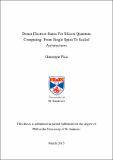Files in this item
Donor electron states for silicon quantum computing : from single spins to scaled architectures
Item metadata
| dc.contributor.advisor | Lovett, Brendon W. | |
| dc.contributor.author | Pica, Giuseppe | |
| dc.coverage.spatial | 191 | en_US |
| dc.date.accessioned | 2015-11-18T16:38:31Z | |
| dc.date.available | 2015-11-18T16:38:31Z | |
| dc.date.issued | 2015-11-30 | |
| dc.identifier | uk.bl.ethos.675209 | |
| dc.identifier.uri | https://hdl.handle.net/10023/7816 | |
| dc.description.abstract | This PhD work took place in the framework of theoretical research aimed at implementation of quantum computing schemes and algorithms in solid state devices. The electron and nuclear spins of dopant atoms implanted in silicon crystals, that already lie at the core of commercial diodes and the photovoltaic industry, are able to store quantum information longer than anything else in the solid state. Controlled manipulations of silicon qubits depend on the ability to tune the nanoscopic donor electron state: we provide a complete theoretical picture that includes, within the insightful and analytic framework of effective mass theory, the effects of the non-trivial silicon conduction band and the different lattice distortions caused by the implantation of the donor species. Calibration of the multi-valley bulk theory to account for binding energies and electron-nuclear hyperfine couplings allows improved estimates of the exchange splittings between two neighbouring donors, that provide the simplest handle for tuning two-qubit operations. Further refinements to our approach lead to exceptional agreement with experimental measurements of Stark effects, where an external electric field is used to enable local single qubit manipulations within global driving fields: we set reliable thresholds on such gating speeds across all group V donors. Finally, we propose a scalable scheme for silicon quantum computing that relies on the coherent transfer of information from Si:Bi donors, that are established as excellent memory qubits, to surface quantum dots that are easier to manipulate, within a topological surface code which enables outstanding tolerance to errors. Analysis of the optimal working regimes and inclusion of the leading sources of decoherence allow us to set out a robust design of the basic building block of future realizations. | en_US |
| dc.language.iso | en | en_US |
| dc.publisher | University of St Andrews | |
| dc.rights | Creative Commons Attribution-NonCommercial-NoDerivatives 4.0 International | |
| dc.rights.uri | http://creativecommons.org/licenses/by-nc-nd/4.0/ | |
| dc.subject | Quantum computing | en_US |
| dc.subject | Doped semiconductor | en_US |
| dc.subject | Quantum control of spins | en_US |
| dc.subject | Effective mass theory | en_US |
| dc.subject.lcc | QA76.889P53 | |
| dc.subject.lcsh | Quantum computing | en_US |
| dc.subject.lcsh | Doped semiconductors | en_US |
| dc.subject.lcsh | Effective mass (Physics) | en_US |
| dc.title | Donor electron states for silicon quantum computing : from single spins to scaled architectures | en_US |
| dc.type | Thesis | en_US |
| dc.type.qualificationlevel | Doctoral | en_US |
| dc.type.qualificationname | PhD Doctor of Philosophy | en_US |
| dc.publisher.institution | The University of St Andrews | en_US |
This item appears in the following Collection(s)
Except where otherwise noted within the work, this item's licence for re-use is described as Creative Commons Attribution-NonCommercial-NoDerivatives 4.0 International
Items in the St Andrews Research Repository are protected by copyright, with all rights reserved, unless otherwise indicated.


